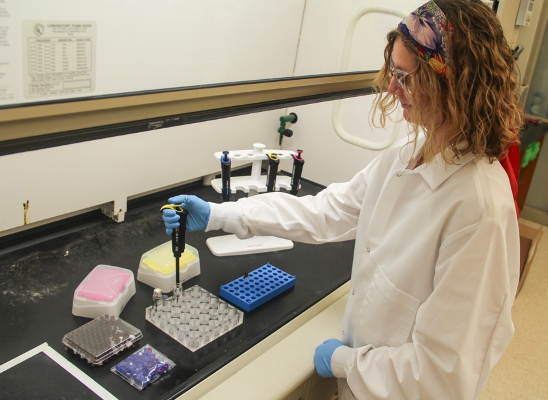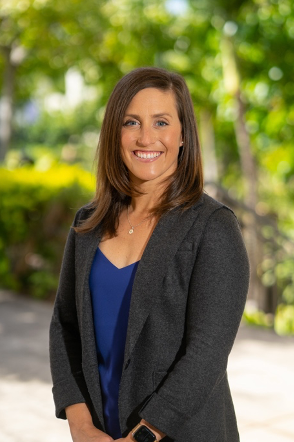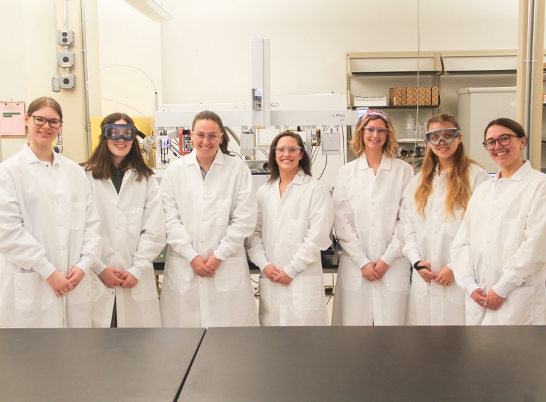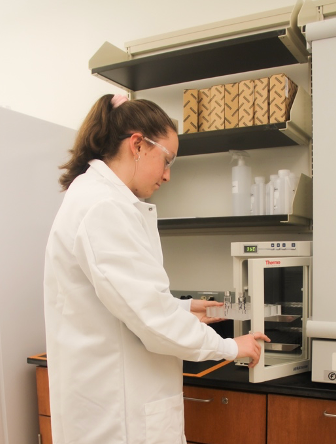Inside the Laboratory: The Nontargeted Separations Laboratory at the College of William & Mary
Inside the Laboratory is a joint series with LCGC and Spectroscopy, profiling analytical scientists and their research groups at universities all over the world. This series will spotlight the current chromatographic and spectroscopic research their group is conducting, and the importance of their research in analytical chemistry and specific industries. In this edition of “Inside the Laboratory,” Katelynn Perrault Uptmor, PhD, an assistant professor of chemistry at the College of William and Mary, discusses her group’s current research endeavors, including using complex comparative data obtained from chemical analysis to understand and solve challenges in forensic science and other life science applications.
The Nontargeted Separations Laboratory is part of the College of William & Mary’s Department of Chemistry, in Williamsburg, Virginia. The group’s tagline is “Separations in Service of Society,” which emphasizes the group’s focus on using comparative data obtained from chemical analysis to understand and solve challenges plaguing the life science industry. The group focuses on developing measurement tools, using chromatographic techniques such as comprehensive two-dimensional gas chromatography (GC×GC), to characterize and discriminate highly complex bioanalytical samples related to life, health, disease, and death.
Emma Macturk (MS Candidate) prepares gas chromatography samples. | Photo Credit: © Katelynn Perrault Uptmor

Katelynn A. Perrault Uptmor is the lead investigator of the Nontargeted Separations Laboratory group at the College of William & Mary. She earned her PhD from the University of Technology Sydney in Australia, specializing in forensic analytical chemistry. Her academic journey also included a Postdoctoral Fellowship at the University of Liège in Belgium. Prior to joining the faculty at William and Mary, Dr. Perrault Uptmor served as a faculty member at Chaminade University of Honolulu in Hawaii.
Perrault Uptmor’s research has garnered widespread recognition because of her contributions to advancing GC×GC. She has received the ACS Satinder Ahuja Award for Young Investigators in Separation Science, the John B. Phillips Award, and the Henry Dreyfus Teacher Scholar Award. She was also named to The Analytical Scientist's Top 40 Under 40 Power List twice.
Recently, LCGC International sat down with Dr. Perrault Uptmor to discuss the current research her laboratory group is conducting, as well as the challenges and process of moving an analytical laboratory across the country.
Dr. Katelynn Perrault Uptmor (pictured) is an assistant professor of chemistry at the College of William & Mary and the lead investigator of the Nontargeted Separations Laboratory | Photo Credit: © Chaminade University of Honolulu

Can you talk about the analytical techniques that your group uses?
We are concerned with nontargeted analytical methods for the comprehensive characterization of complex mixtures. The analysis of samples containing hundreds of compounds is not trivial; it requires sophisticated techniques that allow us to physically separate many components from one another and then couple that separation with a detector that has high sensitivity and broad selectivity. My group is primarily concerned with applications of volatile organic compounds (VOCs), often referred to as odor compounds. We use GC×GC to characterize these VOCs in complex matrices including bacteria, food, natural products, forensic evidence, and more. We are always running what I consider to be the most interesting samples, so new projects tend to bring considerable excitement amongst the group. Currently, we’ve been focusing efforts on decomposition of human remains, gunshot residue, fingerprint residue, bacteria, and fermented beverages. If it has a complex profile, we want to know what’s in it! I’m never surprised by the interesting problems that people approach us with, and I feel that by using chemical instrumentation we can help to solve a lot of problems in our world.
Dr. Katelynn Perrault (center) and her research group at William & Mary. | Photo Credit: © Katelynn Perrault Uptmor

Can you explain the importance of your research within the broader field of analytical chemistry or in a specific industry/application?
One of the main fields that our research focuses on is forensic science. Science has long been an important component of our criminal justice system, but this represents a “coming together” of two fields that don’t always communicate well with one another (science and the law). As chemists, we must think mindfully about what research will be the most practical and beneficial to the criminal justice system at large, not simply just what would be fundamentally interesting for the sake of science. I recently moved my research group to William & Mary where we are now working on new projects that will help advance nontargeted approaches required for evidence analysis to support the adoption of GC×GC as a routine tool in forensic laboratories. For example, we are working on an interesting project to determine whether we can detect traces of external contaminants (for example, chemical threats, cosmetics, drugs, and explosives) within a fingerprint that someone has deposited. The goal is to explain a suspect’s past activities when the fingerprint might not be suitable for identification purposes. Our analytical method development must be driven by use-inspired science. That is a fancy way of saying that we must think about how something could be practically implemented in routine use to be broadly beneficial to the people using the science. In forensic science, we have the extra requirement of also considering how the techniques we develop can be communicated to non-scientific stakeholders (for example, to investigators, attorneys, judges, juries, media reporters, and more). We also think critically about making scientific research papers accessible and explainable to all audiences, all the while still maintaining analytical best practices.
Kira Fisher (BS in Chemistry sophomore researcher) preparing samples for incubation | Photo Credit: © Katelynn Perrault Uptmor

How do you stay updated with advancements in analytical chemistry techniques and technologies?
I like to think that teaching at an undergraduate level keeps me on my toes to be sure I am teaching my students about cutting-edge technologies out there beyond what simply interests me for research. I am always looking at new peer-reviewed papers, magazines, news articles, and white papers to see what I can incorporate into my classes that the students will find exciting. Beyond doing my own web-based research into new advancements, I attend at least one or two analytical chemistry conferences each year. I really like the small-to-medium size conferences where I get to browse more sessions, compared to larger conferences where I often must pick and choose between multiple sessions that I find exciting. I make a point to sit in conference sessions outside my direct field of research to see what new advancements and technologies are shaking things up. I am so relieved that we are back to in-person conferences at this stage. Returning from conference trips always leaves me feeling intellectually rejuvenated. There is something about going away and being immersed momentarily in your field of science that has the tendency to spur new ideas.
Can you discuss a recent innovation or development that you find particularly impactful or exciting?
Being from the GC field, I am thrilled to see companies promoting the use of alternative carrier gases like nitrogen or hydrogen as opposed to helium. In my prior faculty position in Honolulu, Hawaii, we had major challenges surrounding the use of helium related to exponential price increases and supply chain shortages. Our new instrumentation can operate entirely on hydrogen, and we are currently performing independent studies to guide other users in making this type of transition. There are still some challenges to work out using hydrogen with GC analysis, and some additional challenges working with hydrogen for GC×GC, but I think we are quickly moving towards the reality that we can interchange between carrier gases quickly and easily for many applications.
Sarah Foster (Undeclared freshman researcher) learning to use comprehensive two-dimensional gas chromatography. | Photo Credit: © Katelynn Perrault Uptmor

You recently moved your laboratory from the Chaminade University of Honolulu to the College of William & Mary. Could you describe the logistical challenges you encountered when moving your laboratory cross-country?
When I was in graduate school, I went through the process of relocating from one institution to another when my research advisor changed faculty positions from Toronto, Canada, to Sydney, Australia. Deciding to make this move was probably one of my best personal and professional decisions. During that time, I learned what my supervisor went through in moving and setting up a new laboratory and I got to be involved closely in the process. It taught me a lot about how to approach my own laboratory setup both at Chaminade University of Honolulu in 2017 and now for a second time at William & Mary in 2023.
Transferring a research program from one institution to another is challenging even when there is not a major ocean between your origin and destination. However, many faculty transition from one institution to another at least once in their academic careers. I was fortunate that William & Mary provided a lot of advice and support in making the transition. Because my research program is significantly undergraduate-driven, I did not have to convince my students to make the transition alongside me. There are a lot of other things to consider, including transfer of equipment, transfer of continuing grant funding, departmental collaborations, and access to software and historical data. My goal was to minimize downtime between positions which can really set back productivity—research metrics do not “hold off” while we relocate or have other major life events going on, unfortunately. For some of us that are not citizens of the country they work in, work authorization transfer is also an added consideration that must be handled carefully when moving from one institution to another.
Being an avid list-maker, I started approximately five months prior to my move making lists of different approvals and logistical planning that needed attention. I also had a lot of meetings with different administrative teams at both my origin institution and destination institution during that time. Even seven months after starting at William & Mary, I am still working out some of the logistics of the move, so it is no small task. At this point, I’ve been able to work out my recruitment strategy and build up my research group. It has been exciting as I have access to a lot of enthusiastic emerging scientists, and they keep me motivated through all the troubleshooting. I hope that by them being involved in the process of getting my laboratory setup, I’ll be passing on key skills my PhD advisor passed to me many years ago.
Beyond all else, this type of major relocation is an exercise in adaptation and change (one of the core Marianist values of Education from Chaminade University of Honolulu) and has allowed me to find a place of belonging and flourishment (two of William & Mary’s core values). I think it’s important to recognize that every part of your path impacts your destination, and I know that my research here at William & Mary will be even more impactful because of my past experiences.





